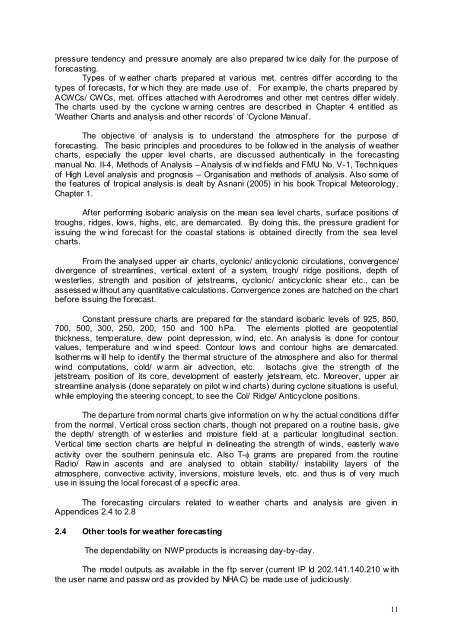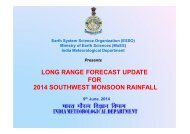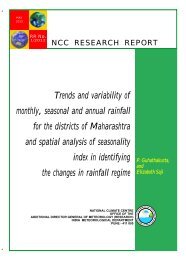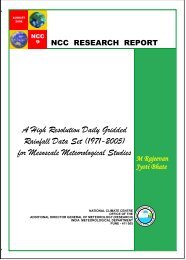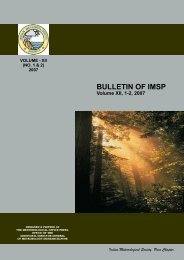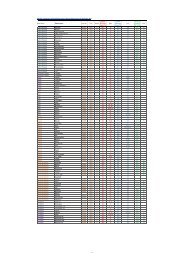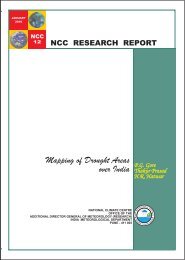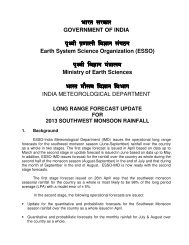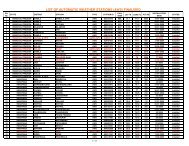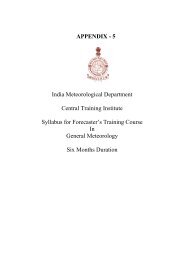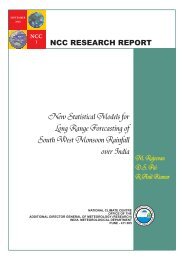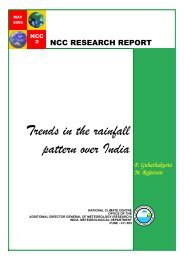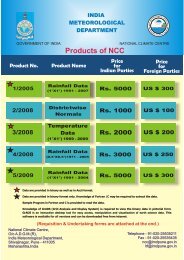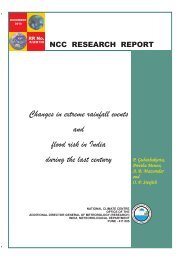Forecasters Guide - (IMD), Pune
Forecasters Guide - (IMD), Pune
Forecasters Guide - (IMD), Pune
You also want an ePaper? Increase the reach of your titles
YUMPU automatically turns print PDFs into web optimized ePapers that Google loves.
pressure tendency and pressure anomaly are also prepared tw ice daily for the purpose of<br />
forecasting.<br />
Types of w eather charts prepared at various met. centres differ according to the<br />
types of forecasts, for w hich they are made use of. For example, the charts prepared by<br />
ACWCs/ CWCs, met. offices attached with Aerodromes and other met centres differ widely.<br />
The charts used by the cyclone w arning centres are described in Chapter 4 entitled as<br />
‘Weather Charts and analysis and other records’ of ‘Cyclone Manual’.<br />
The objective of analysis is to understand the atmosphere for the purpose of<br />
forecasting. The basic principles and procedures to be follow ed in the analysis of weather<br />
charts, especially the upper level charts, are discussed authentically in the forecasting<br />
manual No. II-4, Methods of Analysis – Analysis of w ind fields and FMU No. V-1, Techniques<br />
of High Level analysis and prognosis – Organisation and methods of analysis. Also some of<br />
the features of tropical analysis is dealt by Asnani (2005) in his book Tropical Meteorology,<br />
Chapter 1.<br />
After performing isobaric analysis on the mean sea level charts, surface positions of<br />
troughs, ridges, lows, highs, etc, are demarcated. By doing this, the pressure gradient for<br />
issuing the w ind forecast for the coastal stations is obtained directly from the sea level<br />
charts.<br />
From the analysed upper air charts, cyclonic/ anticyclonic circulations, convergence/<br />
divergence of streamlines, vertical extent of a system, trough/ ridge positions, depth of<br />
westerlies, strength and position of jetstreams, cyclonic/ anticyclonic shear etc., can be<br />
assessed w ithout any quantitative calculations. Convergence zones are hatched on the chart<br />
before issuing the forecast.<br />
Constant pressure charts are prepared for the standard isobaric levels of 925, 850,<br />
700, 500, 300, 250, 200, 150 and 100 hPa. The elements plotted are geopotential<br />
thickness, temperature, dew point depression, w ind, etc. An analysis is done for contour<br />
values, temperature and w ind speed. Contour lows and contour highs are demarcated.<br />
Isotherms w ill help to identify the thermal structure of the atmosphere and also for thermal<br />
wind computations, cold/ w arm air advection, etc. Isotachs give the strength of the<br />
jetstream, position of its core, development of easterly jetstream, etc. Moreover, upper air<br />
streamline analysis (done separately on pilot w ind charts) during cyclone situations is useful,<br />
while employing the steering concept, to see the Col/ Ridge/ Anticyclone positions.<br />
The departure from normal charts give information on w hy the actual conditions differ<br />
from the normal. Vertical cross section charts, though not prepared on a routine basis, give<br />
the depth/ strength of w esterlies and moisture field at a particular longitudinal section.<br />
Vertical time section charts are helpful in delineating the strength of winds, easterly wave<br />
activity over the southern peninsula etc. Also T- grams are prepared from the routine<br />
Radio/ Raw in ascents and are analysed to obtain stability/ instability layers of the<br />
atmosphere, convective activity, inversions, moisture levels, etc. and thus is of very much<br />
use in issuing the local forecast of a specific area.<br />
The forecasting circulars related to w eather charts and analysis are given in<br />
Appendices 2.4 to 2.8<br />
2.4 Other tools for weather forecasting<br />
The dependability on NWP products is increasing day-by-day.<br />
The model outputs as available in the ftp server (current IP Id 202.141.140.210 w ith<br />
the user name and passw ord as provided by NHA C) be made use of judiciously.<br />
11


